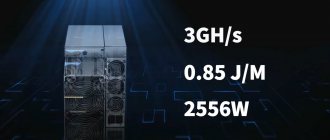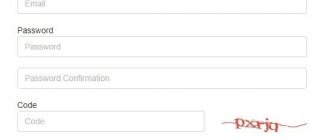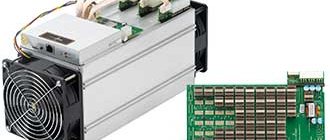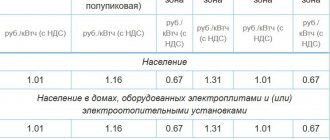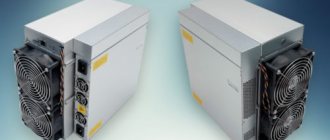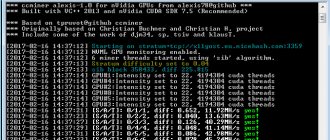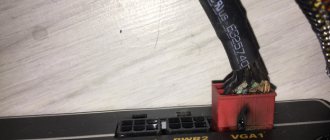About an hour has passed since the company tweeted. This is what he looked like.
Introducing the #AntminerZ11 that packs 3X more hashing power than its predecessor! The Z11 mines #Zcash under the Equihash algorithm. Performing with a hash rate of 135 KSol/s and power consumption of 1418 W. Click here (https://t.co/woThhXNxjd) to learn more. pic.twitter.com/HzCLKR7dVc
— Antminer_main (@Antminer_main) March 19, 2019
The developers focus on high computing power and good energy efficiency.
Source: Shop.bitmain
What is ASIC
The term ASIC is an abbreviation of the English name Application Specific Integrated Circuit. The term has a translation; the device can be called an integrated circuit. But the tracing paper from the English abbreviation has taken root in the Russian language. When working on this device, the same principles are used as for mining on a computer. A large number of complex calculations are performed. For this, the miner receives a reward - Bitcoin.
ASIC miner Bitmain Antminer s19
Technically, an ASIC is a microchip designed to perform only one specific type of task. This allowed for faster computations for mining compared to computers that are multitasking devices. With the help of this equipment, mining Bitcoin has become a more profitable activity.
ASIC consists of a board with microcircuits, a RAM unit, and a cooling system. These components are placed in a housing equipped with connectors for connecting to other gadgets. The table in the manufacturer's catalog usually shows the technical characteristics (memory capacity, power) in sufficient detail.
The main feature of ASIC mining
Each cryptocurrency is based on a specific hashing algorithm. ASIC is a device that supports only one algorithm. But this algorithm can support several currencies at once - for example, Bitcoin and related coins. Some manufacturers produce models that make it possible to mine two coins at once, based on different algorithms. For example, it could be Bitcoin and Litecoin. In practice, this means that two chips are installed in one case, one for each algorithm.
A good ASIC operates with high performance and low energy consumption. Where today one such device is enough for mining, previously it would have been necessary to build a farm of video cards.
Other features of ASIC mining that you need to know before purchasing:
- devices are very noisy due to many fans;
- It is almost impossible to eliminate the breakdown of elements on your own; the help of specialists is required;
- you need a high-quality power supply for the device;
- As mining difficulty increases, new equipment will be required.
Questions about S9
How long does it take on average for an S9 on Hiveon ASIC to start with auto-tuning?
The speed of auto-tuning depends on the state of the chips. If the ASIC is new, it works for up to 10 minutes. If the chips are worn out, it may take half an hour or more until each chip selects a parameter.
How to set a static IP for S9 in the improved Hiveon ASIC firmware? The following error occurs: “Exec failed, exitcode=127, bash:netconf-set:command not found.” Hiveon ASIC version 1.02; 0.1-13.
Unfortunately, there is no netconf-set utility in the firmware, but you can run the command cat /config/network.conf ?.
First command:
printf 'hostname=%s\nipaddress=%s\nnetmask=%s\ngateway=%s\ndnsservers=»%s»\n' 'pir 47 nov' '192.168.1.40' '255.255.255.0' '192.168.1.1 ' '8.8.8.8' > /tmp/network.conf
Second team. You need to check if all addresses are correct:
cat /tmp/network.conf
But that's not all the teams are. After visually checking the addresses, you will need to give a command to use them:
mv /config/network.conf /config/network.conf.old && mv /tmp/network.conf /config/network.conf && sync && echo 'ok' > /config/network_restart
Be careful: the command will irreversibly and without any checks force the ASIC to work with the addresses that we specified in the first command. Just in case, it is advisable to have physical access to the ASIC to reset it.
How to disable Asic Boost in S9 firmware?
If you connect to a pool without Asic Boost support, this mode will not turn on. However, we recommend using a pool that supports this mode. This will reduce power consumption and increase speed.
S9 on Hive OS writes “fee pool error” in the log once every 30 minutes and reboots the miner. Why?
Most likely, access to slushpool is blocked on your firewall. Dev fee goes to slushpool. If there is no connection to it, the ASIC reboots.
How to treat a virus on S9/S10?
Try the following steps:
- Write the image to the SD card, rearrange the jumper on the board and turn on the miner
- First, 2 lights will blink simultaneously, you need to wait until the lights start blinking sequentially
- Remove the card and return the jumper to its place, restart the miner (on power supply)
The SD image is suitable for removing Antbuild on any Antminer S9 firmware. Since Antbuild burns processor fuses, a regular firmware update after “treatment” will return the problem of two lamps, and the miner will stop loading. To prevent this from happening, you need to delete several files from the firmware.
Open the firmware file in 7zip and delete the following files from the xilinx : BOOT.bin, devicetree.dtb and uImage. We save the changes, after which you can update the miner using the modified firmware file without fear of the return of two lamps. Any subsequent update to the miner will also need to follow the above steps to modify the firmware
Recovery image: https://download.hiveos.farm/asic/repo/fw/Antminer/recovery/antbuild_v1_recovery_s9.img
Please note that this image can only handle Antbuild v1. Modern viruses, such as Antbuild v2, cannot be “cured” or removed. The issue can only be resolved by replacing the entire processor or control board.
Basic parameters for choosing ASIC
When choosing an ASIC miner, you need to pay attention to:
- hashing algorithm, since the extraction of a specific cryptocurrency depends on this;
- hashrate, or computing power - it is indicated by a table with characteristics;
- processor operating frequency. The miner’s performance, its speed, as well as the degree of hashrate directly depend on it (it is important to remember that these are not the same thing!). The higher the frequency, the more efficient the work will be.
- power consumption (although it is low, the device runs non-stop, these costs add up to a significant amount). Of course, you should try to find a product with minimal power consumption at the same time as a high hashrate;
- approximate income from mining.
To calculate the potential profit that a good ASIC will give, you can use a special calculator program. It’s worth reading reviews and testimonials from miners first
.
What types of ASICs are there?
ASICs can be professional, for home use, or compact.
They differ in their cost and power. When choosing an ASIC, you need to pay attention to energy efficiency and hashrate. Before purchasing a device, be sure to read all the information provided by the manufacturer. Keep in mind that you can only mine one coin, and therefore you need to analyze which currency will be more profitable.
ASIC consists of the following elements:
- board with microcircuits;
- coolers;
- connector;
- RAM block;
- cooling system.
All these components are placed under a housing equipped with connectors for connections with other devices.
useful links
Where can I download the firmware?
You can download the firmware here.
How can I install the firmware if I am not yet a Hive OS user?
Follow our installation guide.
How to install firmware via Hive OS web interface?
Follow our installation guide.
Where can I find recovery firmware?
Here.
In addition to ASICs, I use GPU rigs. Where can I get help setting them up?
In our specialized chat.
I have firmware from MSK. How to install a Hive OS client for monitoring and managing ASICs?
For Antminer S9 (MSKMINER) and S10 (MSKMINER), replacing the firmware with Hiveon ASIC is only possible via an SD card.
What are the meanings of ASIC indicator lights?
Here you can get acquainted with the meanings of the miner's light signals and ways to solve problems.
How to set up notifications?
You can receive the following notifications in Telegram or Discord:
- Login
- Changing worker status (online/offline)
- Loading the device
- Restarting the device
- Overheat
- CPU overload
- Increasing fan speed
- Ineffective miner operation
- Critical errors
Setting up notifications in Telegram:
- If you don't have Telegram yet, download it to your smartphone or computer and create an account.
- Find @hiveosbot and start a chat with him.
- You don't need to message the bot yet—as soon as you start a chat, you'll receive a message with a code.
- In Hive OS, find the Notifications . Enter a code.
- After you have entered the code, send the following message to the bot: /user yourlogin
Replace “Yourlogin” with your login for Hive Os.
- That's all! On the left side of the Notifications , you will be able to enable specific notifications.
In addition, you can add this bot to a group chat, so that your administrators can monitor workers too. To do this, create a group and add @hiveosbot as a member. For a group, the code will be negative (for example, “-123456”).
Setting up notifications in Discord:
- If you don't have a server yet, open Discord and click on the plus icon. Next, enter the server name, select the region and click on the Create . We use “MyHive” as an example.
- Create an invitation link.
- Go to your farm's settings page and select the Discord in the notifications section. You will see a link there - click on it to invite a Discord bot to your server.
- Authorize adding a bot to Discord:
- Enter the command hive.start in Discord:
- The bot will respond to you with an authorization code:
- Copy the authorization code and paste it into the Discord notifications tab in your farm setup. Click the Subscribe .
- Send the command according to the instructions in the web interface:
If you did everything correctly, your status will change to Subscribed . In a Discord bot, it looks like this:
- Test the bot with several commands. We used the hello command and the non-existent hello11 command:
Messages from the Discord Hive bot are available on the server, which means everything is working correctly.
What cryptocurrencies can be mined?
Any ASIC miner is designed to support a specific hashing algorithm. Most of the equipment on the market was designed for SHA-256. This is the most common option. It was created for Bitcoin, so it allows you to mine Bitcoin Cash, BSV, and less popular altcoins associated with this cryptocurrency.
ASIC bitcoin miner
They produce ASIC miners based on other algorithms and designed for:
- Ethereum and other Ethash-based currencies;
- shieldcoins on X11 (small cap cryptocurrencies);
- Dogecoin, Litecoin, Omni and other cryptocurrencies based on the Scrypt algorithm;
- Monero, ByteCoin on the algorithm
Device manufacturers regularly review their product lines, and the production of models for individual algorithms and cryptocurrencies running on them may be phased out. In 2022, for example, several models for altcoins were discontinued.
Advantages and disadvantages of ASIC miners
The advantages of ASIC miners include:
- quick start;
- low power consumption compared to video cards and processors;
- easy care;
- high hashrate;
- The optimum ratio of price and quality;
- ease of installation and connection of equipment.
But no matter how good and attractive ASIC miners are, they have a number of disadvantages:
- noise and heat generation;
- the need to purchase a separate power supply (only for powerful ASIC miners);
- there are few experienced specialists who can repair equipment if necessary;
- rapid obsolescence.
ASIC Mining Comparison Chart
| Model | Hashrate | Efficiency |
| ASICs for mining using the SHA256 algorithm | ||
| Bitmain Antminer S19 Pro | 110 Th/s | 29.5 W/Th |
| MicroBT Whatsminer M30S++ | 112 Th/s | 32.5 W/Th |
| MicroBT Whatsminer M30S+ | 100 Th/s | 34 W/Th |
| Bitmain Antminer S19 | 95 Th/s | 34 W/Th |
| Canaan Avalon Miner 1246 | 90 Th/s | 36 W/Th |
| MicroBT Whatsminer M30S | 86 Th/s | 37 W/Th |
| Bitmain Antminer T19 | 84 Th/s | 38 W/Th |
| Canaan Avalon Miner 1166 Pro | 81 Th/s | 39 W/Th |
| Bitmain Antminer S17+ | 73 Th/s | 40 W/Th |
| MicroBT Whatsminer M31S | 76 Th/s | 42 W/Th |
| Bitmain Antminer S17e | 64 Th/s | 45 W/Th |
| Bitmain Antminer S17 | 59 Th/s | 40 W/Th |
| Canaan Avalon 1166 | 68 Th/s | 47 W/Th |
| Innosilicon T3+ | 67 Th/s | 49 W/Th |
| Bitmain Antminer T17 | 64 Th/s | 50 W/Th |
| MicroBT Whatsminer M21S | 58 Th/s | 57 W/Th |
| Canaan Avalon 1146 | 56 Th/s | 57 W/Th |
| Bitmain Antminer T17e | 53 Th/s | 57 W/Th |
| Ebang EBIT E12+ | 50 Th/s | 45 W/Th |
| ASICs for mining using the Equihash algorithm | ||
| Bitmain Antminer Z15 | 420 kh/s | 3.6 W/kh |
| Bitmain Antminer Z11 | 135 kh/s | 10.5 W/kh |
| Innosilicon A9++ ZMaster | 140 kh/s | 11 W/kh |
| Innosilicon A9+ ZMaster | 120 kh/s | 11.25 W/kh |
| Innosilicon A9 ZMaster | 50 kh/s | 12.5 W/kh |
| ASICs for mining on the X11 algorithm | ||
| StrongU STU-U6 | 440 Gh/s | 5 W/Gh |
| Spondoolies SPx36 | 540 Gh/s | 8 W/Gh |
| FusionSilicon X7+ | 320 Gh/s | 6.25 W/Gh |
| FusionSilicon X7 | 262 Gh/s | 4.9 W/Gh |
| ASIC for mining on the X12 algorithm | ||
| BlackMiner F1+ | 65 Gh/s | 13.85 W/Gh |
| ASICs for mining using the Blake256R14 algorithm | ||
| StrongU STU-U1++ | 52 Th/s | 42 W/Th |
| MicroBT Whatsminer D1 | 48 Th/s | 48 W/Th |
| Bitmain Antminer DR5 | 34 Th/s | 53 W/Th |
| StrongU STU-U1+ | 12 Th/s | 60 W/Th |
| ASICs for mining using the Lyra2REv2 algorithm | ||
| FusionSilicon X1 | 12.96 Gh/s | 85 W/Gh |
| Dayun Zig Z1 Pro | 13 Gh/s | 115 W/Gh |
| ASICs for mining using the Blake 2B algorithm | ||
| Obelisk SC1 Immersion | 2.2 Th/s | 727 W/Th |
| Obelisk SC1 Dual | 1.10 Th/s | 818 W/Th |
| Obelisk SC1 Slim | 550 Gh/s | 820 W/Th |
| ASICs for mining using the Scrypt algorithm | ||
| Bitmain Antminer L7 | 9.5 Gh/s | 360 W/Gh |
| Innosilicon A6+ LTC Master | 2.2 Gh/s | 955 W/Gh |
| Goldshell LT5 | 2.05 Gh/s | 1014 W/Gh |
| Innosilicon A6 LTCMaster | 1.23 Gh/s | 955 W/Gh |
| Bitmain Antminer L3++ | 596 Mh/s | 1220 W/Mh |
| ASIC for mining using the Tensority algorithm | ||
| Bitmain Antminer B7 | 96 kh/s | 5.5 W/kh |
| ASIC for mining using the CryptoNight algorithm | ||
| Antminer X3 | 220 kh/s | 2.27 kh/s |
| ASICs for mining on the Ethash algorithm | ||
| Bitmain Antminer E9 | 3 Gh/s | 0.85 W/Mh |
| Innosilicon A11 Pro ETH | 2 Gh/s | 1.25 W/Mh |
| Innosilicon A10 Pro+ 7GB | 750 Mh/s | 1.75 W/Mh |
| Innosilicon A10 ETHMaster 500 | 500 Mh/s | 1.5 W/Mh |
Mining algorithms
- SHA-256 . It is the basis of the first digital money - bitcoins and several other cryptocurrencies (Bitcoin Cash and others). Deciphered by the following ASICs: Bitmain Antminer S9 (14 TH/s; 1340 W); Asic T9 Antminer from Bitmain (11.5 TH/s; 1450 W); Asic Bitmain Antminer V9 (11.5 TH/s; 1450 W); WhatsMiner M3 ASIC Miner (12.5 TH/s; 1576 W); DragonMint T1 from Halong Mining (16 TH/s; 1600 W); Ebit E10.1 Miner 18T from Ebang Communication (18 TH/s; 1600 W).
- Scrypt . It is the basis of existence of Likecoin and many other digital currencies. Its code is decrypted using Asic Antminer L3+ from Bitmain - an improved version of Asic L3 (504 MH/s; 800 W); A6 LTCMaster from Innosilicon (1.23 GH/s; 1500 W); A4+ LTCMaster from Innosilicon (620 MH/s; 750 W).
- Cryptonight . It can be mistaken for Cryptonote technology, which uses this algorithm. Thanks to him, Bytecoin, Monero and Electroneum operate. Decryption occurs due to Asic Antminer X3 from Bitmain (220 KH/s; 550 W); Giant-N from Baikal (20 KH/s; 60 W); DragonMint X2 Miner from Halong Mining (248 KH/s; 490 W); DragonMint X1 Miner from Halong Mining (124 KH/s; 245 W).
- Ethash (Dagger Hashimoto) . For now, decryption is carried out using video cards, but in the near future this process will be modernized. Development of a previously unseen ASIC for ether is underway – Antminer F3.
- Blake (2b) . The following algorithms are being worked on: Asic A3 Antminer from Bitmain (815 GH/s; 1275 W); Giant-B from Baikal (80 GH/s; 300 W); DragonMint B52 Blake2b Miner from Halong Mining (3.83 TH/s; 1380 W).
- X11 . A popular algorithm that powers the Dash currency. At the moment, the feasibility of mining currencies on it has decreased somewhat, because much more powerful miners have appeared, significantly complicating the network structure. However, many ASICs work with it: Asic Antminer D3 from Bitmain (19.3 GH/s; 1100 W); A5 DashMaster x11 asic miner from Innosilicon (32.5 GH/s; 750 W); DR-100 PRO from Pinidea (22 GH/s; 900 W); Giant X10 from Baikal (10 GH/s; 630 W).
cryptocurrencies cryptocurrencies cryptocurrencies devices devices devices devices devices devices miners hashrate miners hashrate hashrate hashrate hashrate hashrate hashrate hashrate hashrate 1 2 3 4 5 6 7 8 9 10 11 propro power power power power best new new new new mining mining mining the most the most the most the most payback payback payback work sha month month month time btcbtc blockchain blockchain blockchain consumedconsumable farmsfarms consumption cooling cooling cooling noise noise rating energy energy energy indicators indicators term case case case base usage baseuse day very very very find find news news news exchange gpu wallet top firmware weight profitable productive level beginners average soon just influences costs demand author decided old most read the method will be popular relevant exactly note installations beginning suitable large guarantee Internet situation list question to do ready to say example interesting uses financial business stores materials creation suitable search solutions place order
Manufacturers of ASIC miners
Before you buy an ASIC on which you want to make money, you need to choose a currency and become familiar with the brand of equipment. Below we list popular manufacturers that produce equipment for making money on the most famous currencies.
Bitmain
This is a popular manufacturer of ASIC miners for Bitcoin mining.
In 2021, two modern mining models were released: Bitmain Antminer S19 and S19 pr. They are characterized by high power and, according to analysts, will be in demand until 2022. Today these models are market leaders. The hashrate of the first model is 95 TH/s, the second model has 15 units more. Although the difference in this parameter is not big, the cost varies greatly. The S19 will cost $2,120, and the Pro model will cost $3,770. Bitmain releases new models more often than other manufacturers, improving their parameters. Until 2022, the following models were in demand: Bitmain Antminer e3, e9, f3, g2, l3, l7, s7, s9, s15, s17.
Innosilicon
Previously, the manufacturer Bitman produced ASICs for Ethereum mining. But in 2021-2022, the brand began to produce only equipment for Bitcoin. Innosilicon sells aisic for $2,500. But experienced players recommend before purchasing such equipment to calculate whether it will be profitable to mine this currency.
Baikal
This manufacturer is not as popular as the first two, but it produces silent ASIC models. The company has been operating since 2006. One of the popular models today is mini X11 Miner. Buyers choose this model due to its high performance and stable operation.
Bitfury
This brand creates equipment for earning Bitcoin. It is manufactured in the UK and was launched in 2011.
General issues
What is Hiveon ASIC?
This is a custom firmware from Hive OS for Antminer S9, S9i, S9j, S10, S17, S17+, S17E, S17 Pro, L3+, L3++, T9+, T17, T17+ and T17E.
What does the firmware provide?
- Acceleration of worn out ASIC chips;
- Selection of paid voltages and frequencies automatically and manually;
- Fine tuning of frequencies individually chip by chip;
- When the Internet goes out, the chips stop consuming electricity;
- Antivirus protection;
- Restoring devices that were previously infected with viruses;
- Flashing LEDs on ASIC in case of fan or chip failure;
- Built-in Wattmeter;
- Watchdogs by temperature, hashrate;
- When using the firmware, Hive OS is free.
You can learn more about the features of each firmware on our website.
And here you can learn about the difference between the Hiveon ASIC firmware and the Hive OS client.
Is there firmware for Antminer T15?
Standard firmware with a built-in Hive OS client is available for monitoring the operation of your ASICs.
Why is there no firmware for S11, Z9?
On these models, the power distribution does not allow for much squeezing, so there is no point in updating the firmware. Use stock.
Can it be added to Hive OS S15?
Currently, only a monitoring client is available for this model. Auto overclocking is already built into the factory Bitmain firmware.
Is Innosilicon t2t 32th supported?
At the moment, there is no Hiveon firmware for this model and there are no plans to do so. You can only install a client for monitoring. Guide here.
How much does the firmware cost?
The firmware assumes a dev fee - parallel mining, without drawdowns and suspension of the main mining:
- S17 / S17+ / S17E / S17 Pro: 2.8%
- T17 / T17+ / T17E: 2.8%
- L3+ / L3++: 1.8%
- S10: 2%
- S9/S9j/S9i: 2%
- T9+: 2%
In details:
Technically, our DevFee is time-based. The significant difference is that
a) we wait for the completion of work on the current ball;
b) when switching to DevFee, the miner does not restart.
We wait for the ASIC to finish working on the ball, then we very quickly switch to low difficulty fee, with fast small balls, then switch back to main mining. As a result, there is no downtime in the form of waiting, miner restarts and no unresolved shares.
If I already have 3 GPU workers and I connect one Antminer, will I have a paid account?
No, with our firmware the account remains free. In the case of using third-party firmware with the Hive OS client, the standard price for up to 50 devices is $2/month from one ASIC.
I use ASICs with Hiveon firmware, why does my Hive OS indicate that paid features are enabled?
These features are enabled when the farm is paid for. With money or with the help of a fee - there is no difference. In this particular case, payment is made through a commission “built-in” to the Hiveon firmware.
What is the latest Hiveon ASIC firmware version?
For S9 Hiveon 1.02 (there is beta 1.03). For T9+ Hiveon 1.02.
Can someone write firmware specifically for my ASICa?
Yes, but it's quite expensive. Let's say the developer's salary is $2500 per month. The work itself will take several months.
The best types of ASICs for mining in 2021-2022
Before choosing a new ASIC, you need to find out which brands are the leaders. To mine Bitcoin, you can look at equipment from Bitmain. The basic line for this cryptocurrency is Antminer S and T, which, in addition to Bitcoin, allows you to mine other coins using the SHA-256 algorithm.
ASICs for Bitcoin mining
In 2022, Bitmain released two models at once to mine Bitcoin - the Antminer S19 and S19 pro. Both devices have high power, and in the future they will generate profit throughout 2022. The first model has a hashrate of 95 TH/s, and the S19 pro model has a hashrate of 110 TH/s. But the price difference is also serious - $2120 and $3770, respectively. These are the models with the highest performance and efficiency characteristics on the market.
ASIC for Ethereum mining
Previously, devices for mining these coins were also offered by Bitmain. But in 2021-2022, the production of these models was abandoned. For Ethereum, the company Innosilicon offers ASICs - these are the A10 models (priced about $2500).
Before buying equipment, you need to calculate the ratio of price to planned profit in order to understand how profitable such an investment will be.
Comparison of the efficiency of ASICs and video cards - which is more profitable?
Video cards and ASICs are the two main competitors in the world of mining. Each method of earning money has its pros and cons. The main advantage of video cards is the ability to mine any cryptocurrency and choose those that bring more income. ASICs have a limited number of algorithms, and therefore you can select only one currency on one equipment.
You can quickly connect the ASIC system and start earning money. The equipment has a metal case and a small number of components, and therefore it can be transported without disassembly. As for video cards, if transportation is necessary, a lot of time is spent on disassembly and further assembly.
If we talk about payback, then its period for video cards is longer than for ASICs. But if the video card is not needed, it can be sold on the secondary market. ASIC can also be sold, but it will be more difficult, because such equipment costs more than a video card.
ASIC rental for cryptocurrency mining
Due to the high cost of ASica, equipment rental has recently become common.
The main advantage of renting is that you do not need a large sum to purchase. There is also no need to monitor the performance of the ASEC, clean it, or pay large sums for electricity. Most often, rent is meant to be virtual. Some people rent out equipment, but the cost is high. Otherwise, there is no point in passing ASIC if it brings regular income.
Virtual rental has significant disadvantages:
- lack of access to equipment (you can mine only on the cloud);
- high risk of encountering scammers;
L3 Questions
L3+: monitoring and configuration
Check out this video.
L3 with connected monitoring from Hive: after a reboot, overclocking is reset to default. How to solve a problem?
If the firmware is MSK, then overclocking should not fail. It is written to separate files. If the custom is from another author, then after applying the overclocking settings you need to run Miner Config in Hive (or click Miner Config ). In response, you will receive a complete config with overclocking settings. All parameters below the pools should be copied and pasted into Hive into the advanced parameters of the miner on the tuning tab or in the Flight Sheet (if you need massive overclocking).
How and where to buy asic
Most often, people, wanting to save money, buy used ASICs on Avito or similar sites with advertisements. But sellers are selling equipment because it is outdated and has ceased to generate income. Therefore, such a purchase may be irrational.
Most top manufacturers produce equipment in China. Therefore, it is best to order ASIC directly from the manufacturer. Keep in mind that the delivery time for goods from China to Russia can take up to six months. And some manufacturers ship goods only in large quantities. Before making a purchase, read reviews about the manufacturer to make sure that you are not dealing with scammers.
How much does asic cost: prices for popular models
The cost for ASICs starts from $1,000. The maximum price for equipment is not limited. The price of popular models from trusted brands is not low: but it is much more profitable than renting IPCs.
Calculation of profitability and payback of ASICs
The main expense item is mining equipment. Depending on its characteristics, Asics can cost several thousand dollars. The cost of electricity is no less important, because the chips work almost constantly. When choosing a device for yourself, you must first calculate how much electricity it will consume and how much you will need to pay.
To calculate profitability, it is necessary to subtract the cost of equipment, energy costs and maintenance from income. It is very difficult to make calculations manually, and therefore we suggest using convenient calculators on our website.
Calculator for calculating the profitability of ASICs
Bitcoin Asic mining calculator is available at https://wattomine.com/btc. For example, if you want to find out how much ASIC Antminer S17 mines per day, just enter the speed (73 Th), consumption (3000 W) and the cost of electricity (0.06 USD) in the appropriate fields and click the “Make calculation ” button.
Other popular calculators:
- Zcash mining profitability calculator
- Ethereum mining profitability calculator
- Monero Mining Profitability Calculator
- DASH Mining Profitability Calculator
Generalized information about the currently most profitable ASICs is available on the resource https://www.asicminervalue.com/, where the current exchange rate of cryptocurrencies is taken into account, and mining income for different models is also displayed. This site presents a rating of the best ASICs for mining, taking into account even those that will go on sale. It can also be used as an ASIC mining income calculator by entering the electricity cost data corresponding to your local tariff at the bottom of its pages.
Questions about installation, updating, recovery and configuration
How can I update to a new firmware version?
Directly from the Hive OS web interface.
Why may the firmware not install if you sew through the Hive OS web interface?
A firewall or something else with the Internet that blocks the download of the firmware. Try downloading the firmware for the S9 in the farm settings and flashing it through the ASIC web interface.
The ASIC is flashed with the latest Bitmain firmware. I can't install Hiveon ASIC.
The latest Bitmain firmware includes protection against custom firmware. Options:
- Try flashing via SD card. Upload the recovery image to the card.
- Instructions on the forum
- The service center can flash it via the com port.
How exactly to restore the firmware using an SD card?
Turn on the control board and wait 60 seconds for the LEDs to start flashing. The main thing is to wait for constant periodic blinking. They will blink once after 2 seconds, and after exactly 60 seconds they will start blinking continuously.
This image restores the firmware from any state - even with an empty flash drive
- Turn off the miner
- Change jumper to boot from SD card
- Insert SD card
- Launch it. When the diodes blink, remove the SD card
- Turn off the ASIC, move the jumper back
- Go to the ASIC website - flash the required firmware
At the time of starting the ASIC in step 6, there should be no SD card.
I download the firmware from the farm settings. The firmware name contains farm_hash. I install it on the ASIC via the web interface. The ASIC is not automatically bound to Hive OS.
The firmware from the farm settings is automatically linked to Hive OS only for mass installation of firmware from another ASIC or another Linux (Bulk install). If you are flashing via the web interface, you need to enter farm_hash on the Hive OS tab.
Why, if I enter farm_hash or api server in the ASIC web interface on the Hive OS tab, are they not saved?
The API server is saved in the ASIC configuration and is not displayed in the web interface. farmhash is only needed to add an ASIC; with its help, rigid and password are obtained, which are saved in the config. And the hashrate itself is not saved anywhere.
How to use the FARM_HASH generator to mass bind ASICs to a farm on Hive OS?
You can use our FARM_HASH generator.
Any Antminer with Hive OS Client for ASIC: https://download.hiveos.farm/asic/repo/farm_hash/
Antminer S9 / T9 with Hiveon ASIC firmware: https://download.hiveos.farm/asic/repo/farm_hash_hiveon/
Antminer S17 / T17 with Hiveon ASIC firmware: https://download.hiveos.farm/asic/repo/farm_hash_hiveon_17/
You must enter your farm_hash in the web form. The generator then provides you with a special.tar.gz , which you can upload to the ASIC via the web interface or using BTC Tools. This is not a Hiveon firmware file, it is a small configuration file.
You must first install the Hiveon firmware on the ASIC and then flash this configuration file.
Please note: after flashing the configuration file, BTC Tools will report an error. Don't worry, we did this on purpose. The goal is to prevent the standard reboot procedure after flashing. Your farm's farm_hash is entered and the ASIC is linked to your Hive OS account.
We also recommend setting the update timeout to 1200 seconds in BTC Tools and updating no more than 5 ASICs at a time. To do this, you need to go to the BTC Tools settings and set these parameters:
If you take away ASICs and they are not on the internal network, do you need to reconfigure anything?
No. ASICs are not tied to networks and will connect from anywhere where there is Internet.
But, if you set up the network manually and did not receive an IP automatically (for most people this is the case), you may have to reconfigure it.
If the ASIC is in another place and I'm at home, how can I connect to it?
Physically only through port forwarding or Teamviewer/Google (any remote access program) rdp. If the IP is dynamic, then ddns.
How to find ASIC on a local network?
Once your ASIC is turned on and assumes it is on the same network as you, connect to it using a computer or mobile device. Enter your miner's IP address. Most miners come with DHCP enabled, so you don't have to manually set an IP address for it. Instead, look at the IP table on your router or use a scanning tool, such as the Advanced IP Scanner program.
How to disable auto-reboot of an ASIC with one non-working board?
On the ASIC web in the watchdog settings. It is possible that the faulty board is overheating (a reboot due to overheating is provided).
Also, due to a faulty board, the autotuner may work for a very long time. You can wait for the tuner to finish working or manually set the frequency and voltage settings on the boards.
How to get information on ASIC errors?
To receive information about errors in your ASIC, you need to send a command to your worker.
For S9/S9i/S9j/S10: (./get_kernel_log.cgi; ./get_watchdog_log.cgi; ./get_auto_tune_log.cgi) | grep -iE 'red.*chip|chip.*red|fatal|critical|failure|warning|error' | sort
For episode 17: printf '/nvdata/miner_status.log:\n\n'; grep -Ev 'STATUS_INIT|STATUS_OK' /nvdata/miner_status.log | tail -n 20; printf '\n/config/watchdog.log:\n\n'; tail -n 20 /config/watchdog.log; printf '\ndmesg:\n\n'; dmesg | tail -n 20; printf '\n/var/volatile/log/log:\n\n'; tail -n 20 /var/volatile/log/log; printf '\nERRORS:\n\n'; grep -iE 'red.*chip|chip.*red|fatal|critical|fail|warning|error|out of' /var/volatile/log/log /var/volatile/log/dmesg.log /var/volatile/ log/messages; printf '\n\nMESSAGES:\n\n'; grep -vhE '\.notice|\.info|compile time|api_stats|API run' $( find /nvdata -name messages -mtime -10 -type f ) | tail -n 100
For T9: Dmesg
ASIC errors and their interpretation
- ERROR_SOC_INIT - driver initialization error
- ERROR_REOPEN_CORE - error when re-opening cores
- ERROR_FAN_LOST - loss of one or more coolers
- ERROR_POWER_LOST - error in setting voltage, error in determining the type of power supply
- ERROR_EEPROM_INFO - error reading EEPROM contents (incorrect format)
- ERROR_TEMP_LOST - temperature sensor lost two or more times
- ERROR_TEMP_TOO_LOW - temperature too low
- ERROR_PIC_LOST - PIC initialization error on any of the boards
- ERROR_TEMP_LOST_1ST - Restart cgminer to check the temperature sensor type again (most likely the sensor was lost the first time)
- ERROR_UNBALANCE - an imbalance has occurred, reboot
- ERROR_TEMP_TOO_HIGH - above the maximum temperature
- WARN_NET_LOST - loss of network connection
- ERROR_NET_LOST - loss of network connection
Why use the Flight Sheet on firmware?
Without it, it mines using the old parameters and does not show the hashrate in the Hive OS web interface.
Are there any problems with reverse firmware?
There are no problems with reverse firmware, but the standard firmware version is most suitable for this case. The improved version will also work with anything, but first you will need to send a command to the ASIC via the Hive web interface to disable signature verification. No programmers are needed. You can also flash from an improved version to any one via an SD card or the “IP report” button.
Default logins and passwords
Standard password for our firmware:
Login: root
Password:
Please note the "@" symbol.
Almost all users do not change the default ASIC username and password. Soon such an unprotected ASIC will be infected with a virus using a standard password from another infected device on the local network.
Default SSH logins and passwords:
Antminer - default user: root , default password: admin
Innosilicon - default user (ssh/telnet): root , default password: blacksheepwall or innot1t2 or t1t2t3a5
If you previously set other login and password values, then reset the ASIC settings to factory settings. To do this, with the ASICe turned on, hold down ipreport and reset for 20 seconds, turn off the power supply without releasing the pressed buttons. Wait 10 seconds without releasing the ipreport and reset buttons, turn on the power supply and hold ipreport and reset for another 20 seconds. Then release and wait for it to load.
How to change worker RIG ID?
To do this, you need to have physical access to the rig. Connect a keyboard and monitor to it, and enter the command firstrun -f. Alternatively, you can use Hive Shell to make changes remotely. To do this, launch Hive Shell, and in the window that opens, write the command firstrun -f. After that, specify the RIG ID and password.
tar: short read error occurs during installation
When downloading firmware through some browsers (for example Opera on Windows or Safari on Apple), you may encounter a tar: short read error. In this case, we recommend using another browser, such as Google Chrome. This situation can also arise if there is no space on the ASIC, for example due to a large number of log files. In this case, we recommend rebooting the ASIC and trying again.
A tab for binding by farm_hash will appear in the ASIC. And then decide whether to stay on this firmware + Hive OS Client, or change the firmware. You can upgrade to Hiveon or any other firmware from the Hive dashboard.
Please also make sure that you are using ".tar.gz" file for flashing and not ".tar".
Reset settings and return to factory firmware
Please note: resetting to factory settings and reverting the firmware to factory firmware are different actions.
Resetting the ASIC to factory settings can be done within the first 10 minutes after loading the ASIC:
- Reboot the ASIC
- Wait at least 2 minutes
- Hold the Reset button with any sharp object for 5 seconds
- Within 4 minutes, the ASIC will restore factory settings and reboot
- Log in to the ASIC web using the default login and password
/config folder is technically cleared on the ASIC . Only configs are stored in it. From ASIC these are network settings, wallets, web password. From Hive - configs for binding to Hive. From Hiveon firmware - overclocking and tuning profiles.
Return to factory firmware (boot from ASIC backup partition) - this method is only applicable to Antminer S9 (all letters), T9, T9+, which have an SD card slot to the left of the Ethernet connector.
- Turn off ASIC
- Hold down the IP Report button and do not release it
- Enable ASIC
- Wait 5 seconds
- Release IP Report
- Log in to the ASIC web using the default login and password
How to transfer ASIC to another Hive OS account?
You need to log into your ASIC via SSH, write and execute the command firstrun -f, and then enter the new rig ID and password.
Or in the ASIC web perform the following steps: Worker - Settings - Advanced - Transfer Rig
My worker is having problems connecting to the server. What to do?
If you are having trouble connecting your worker to the Hive server and are experiencing false online/offline events frequently, you can try choosing a different URL to connect to the server. Also, sometimes there is a problem with the firewall (your own ISP) and changing the port may help. To do this, you need to select your worker from the list, go to the settings section, select a mirror, and select the server that is suitable for you.
Be careful! Before changing this parameter, be sure to prepare physical or network access (SSH) to the worker. If a worker cannot connect to the selected URL, it will be in an offline state for Hive. The mirror URL is saved in /hive-config/rig.conf, where you can edit it manually by logging into the rig using an SSH client.
Which pools support ASIC Boost technology?
At the moment, the following pools support this technology:
- emcd.io
- viabtc
- slushpool
- oneboost.ru
- f2pool.com
- btc.com
- antpool
- zpool.ca.
Over time, this list may be expanded.
What to do if the required pool is not in the Flight Sheet?
If the pool is not in the list of pools in the Flight Sheet, then select the “Set up miner” pool. In the miner settings, enter the address and port.
Why can't my pool settings be remembered?
Because the Hiveon firmware is configured that way. You need to register on the hiveos.farm website, create a farm there, and enter farm_hash in the ASIC. Next, create a Flight Sheet on the website and enter your settings there. Apply this sheet to the ASIC that appears in the farm on the site, and after that the ASIC will remember these settings when rebooted.
How to force update Hive OS client on ASICe?
To force a client version update, you need to send the command to the ASIC: /bin/sh -c 'screen -d -m -S selfuprade /bin/sh -c “rm -rf /nvdata/latest.tar.gz /hive; /etc/rcS.d/S69hive; hello; message info AgentUpgradeDone"'.
How to rollback ASIC firmware
Use the command /bin/sh -c 'screen -d -m -S selfupgrade selfupgrade 0.1-12'
How to view device logs?
Here are the required commands:
Watchdog log: cat /config/watchdog.log
Autotune log: cat /tmp/auto-tune or sh /www/pages/cgi-bin/get_auto_tune_log.cgi
The kernel log can be viewed directly in Hive OS. Click on the pickaxe icon and go to Miner Log. If this method does not work, run sh /www/pages/cgi-bin/get_kernel_log.cgi.
How to change worker password?
To change the access password, you need to send the worker the command hive-passwd enter_new_password_for_SSH here.
If you have an old version of Hive OS Client, send the command to the worker:
echo "root:antMiner Configuration:$(echo -n "root:antMiner Configuration:$new_pw" | md5sum | cut -b -32)" > /config/lighttpd-htdigest.user
Replace $new_pw with your new password.
How to find out the ASIC time zone?
Enter the date command. It will show the current time and date set on the ASIC.
How to remove Hive from T2T?
Go almost to the very end of the Innosilicon script, delete all lines with “curl” except one. It will execute the command. Replace the systemctl start... command. on systemctl disable... This will disable Hive autoloading. The scripts will remain, but will not interfere.

